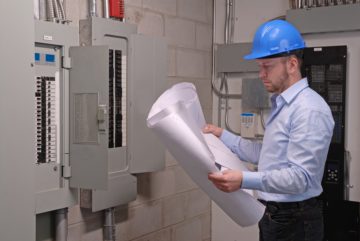
What leads to failing emergency lighting inspections? CMI Lighting can help you avoid these errors.
Emergency lighting is crucial for ensuring the safety and security of a commercial property during power outages or emergencies. However, many properties fail emergency lighting inspections due to oversights and mistakes. Here are some common factors that can lead to failing an emergency lighting inspection and how to avoid them with the help of CMI Lighting.
Improper Circuit Connection
One of the most frequent reasons for failing an emergency lighting inspection is when the emergency lighting system is not connected to the same circuit as the regular lighting. This is crucial because, in the event of a power failure, the emergency lights need to activate immediately and provide adequate illumination. Ensure that your emergency lighting system is correctly connected to the same circuit as your regular lighting to pass inspection and guarantee safety during an outage.
Lack of Battery Backup
Another common issue is emergency lighting that fails to use battery power after the circuit breaker is turned off. This scenario means that your emergency lights won’t function once the power goes out, rendering them useless. Make sure your emergency lighting system includes reliable battery backup power that can automatically activate when the main power supply is interrupted. Regularly test and maintain these batteries to ensure they are in good working condition.
Incorrect Type of Emergency Lighting
Using the wrong type of emergency lighting can also lead to inspection failures. Different environments require specific types of emergency lights to meet safety standards. For example, exit signs, path markers, and area lighting all have unique requirements. Consult with a lighting professional to ensure that you have the appropriate type of emergency lighting installed for your specific needs and that they comply with local regulations and standards.
Inadequate Testing and Maintenance
Consistent testing and maintenance are essential for ensuring that your emergency lighting system functions correctly. Neglecting this can lead to inspection failures due to non-functional lights, depleted batteries, or other issues. Implement a routine testing schedule to check all components of your emergency lighting system, including battery backups and light fixtures. Address any deficiencies promptly to maintain compliance and safety.
Improper Installation
Incorrect installation of emergency lighting can result in failed inspections. This includes improper placement, faulty wiring, or failure to follow manufacturer guidelines and local codes. Ensure that a qualified electrician from CMI Lighting installs your emergency lighting system, following all relevant codes and standards to avoid installation-related issues.
Insufficient Coverage
Another common issue is insufficient coverage, where the emergency lighting does not adequately illuminate all necessary areas. This can include exit routes, stairwells, and common areas. Conduct a thorough assessment of your property to identify all critical areas that need emergency lighting and ensure proper installation to provide comprehensive coverage.
Avoid Issues with CMI Lighting
Failing an emergency lighting inspection can have serious implications for the safety of your commercial property and its occupants. At CMI Lighting, we specialize in providing comprehensive emergency lighting solutions tailored to meet your unique needs. Our team of experts is dedicated to helping you achieve compliance and ensure the safety of your premises during power outages or emergencies. Contact us today to learn more about how we can assist you in maintaining a reliable emergency lighting system.
CHECK OUT COMMERCIAL ELECTRICAL SERVICES FROM CMI LIGHTING
With over 35 years in the industry, CMI has an array of equipment to handle the logistics of any in-house job. We also frequently provide solutions to property managers and upcoming developments. CMI Companies provides services in the Mid-Atlantic Region and proudly serves clients in Northern Virginia, Maryland, Richmond, Southern Virginia, Manassas, Prince William County, Fairfax County, Rockville, and Prince George’s County. Also, check us out on Facebook, Twitter, and LinkedIn.
